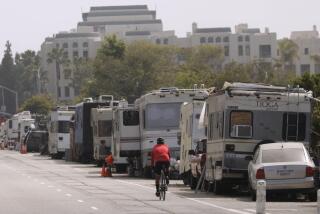Plan for Commuter Lanes Raises Questions : Paid single-occupant use of car-pool lanes bumps into lack of space and the reason for the system posing legal questions.
- Share via
The idea of allowing single-occupant vehicles (SOV) to use high-occupancy vehicle (HOV) car-pool lanes for a fee has received attention recently. Legislation (AB 713) has been proposed for that purpose in San Diego County on Interstate 15. (And the issue was recently raised before the Orange County Transportation Authority.)
While Caltrans has not taken a position on that legislation, I want to share our current thinking on the subject.
The primary purpose of such a proposal should be to improve air quality and transportation service on an areawide, multicorridor basis--not to raise revenue. While improvements in air quality and traffic service need not be mutually exclusive with raising revenue, a focus on revenue could result in decisions detrimental to air quality and less congested transportation service. A key factor, of course, is the availability of excess capacity in the existing commuter lanes during the peak periods.
The pricing structure should encourage multioccupancy use of the vehicles and off-peak usage. And the price must be set so that car pools, van pools and buses are not delayed by the addition of lone-driver cars that are paying to use the lane.
But even if these conditions are achieved, multioccupancy use of vehicles could be discouraged. There could be a perception that the emphasis for car-pooling has decreased because capacity is being sold to cars with a lone occupant.
There must be a system in place to effectively manage these car-pool lanes as an integral part of the State Highway System. This includes pricing as well as the operational aspects such as signing, towing and enforcement.
The environmental document for the HOV projects is based on highway lanes that encourage car-pooling and the movement of people. The use of these lanes for single-occupant vehicles could be open to a legal challenge. And federal approval would also be required for such a change.
Agreement would also need to be reached on an equitable method for sharing net revenue, and how that revenue should be spent. The equity issue is especially important because the traffic lanes were originally paid for from gas tax revenue.
When all of these factor are considered, the car-pool lanes on the freeways in Orange County are not good candidates for allowing drivers of single-occupant vehicles to buy their way onto them because:
* There is virtually no excess capacity in car-pool lanes during congested periods.
* It is not operationally feasible to set up a system to properly manage such a process where frequent entrances and exits are needed as on existing car-pool lanes.
* The layout of the current car-pool lanes with frequent entrances and exits would not allow adequate enforcement.
* There could be a legal challenge based on the purpose of the project as described in the environmental document.
This proposal is significantly different from congestion pricing. For example, the congestion pricing being planned for the Riverside Freeway privatization project will have an operational system that can be effectively managed. It will also have the restricted access needed for proper enforcement.
And congestion pricing does have the potential for improving air quality and transportation service.
More to Read
Sign up for Essential California
The most important California stories and recommendations in your inbox every morning.
You may occasionally receive promotional content from the Los Angeles Times.













